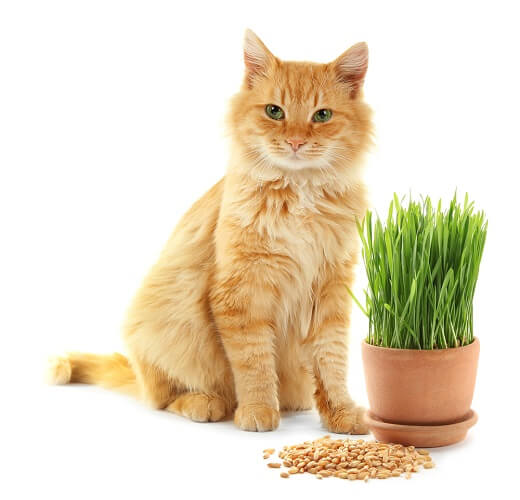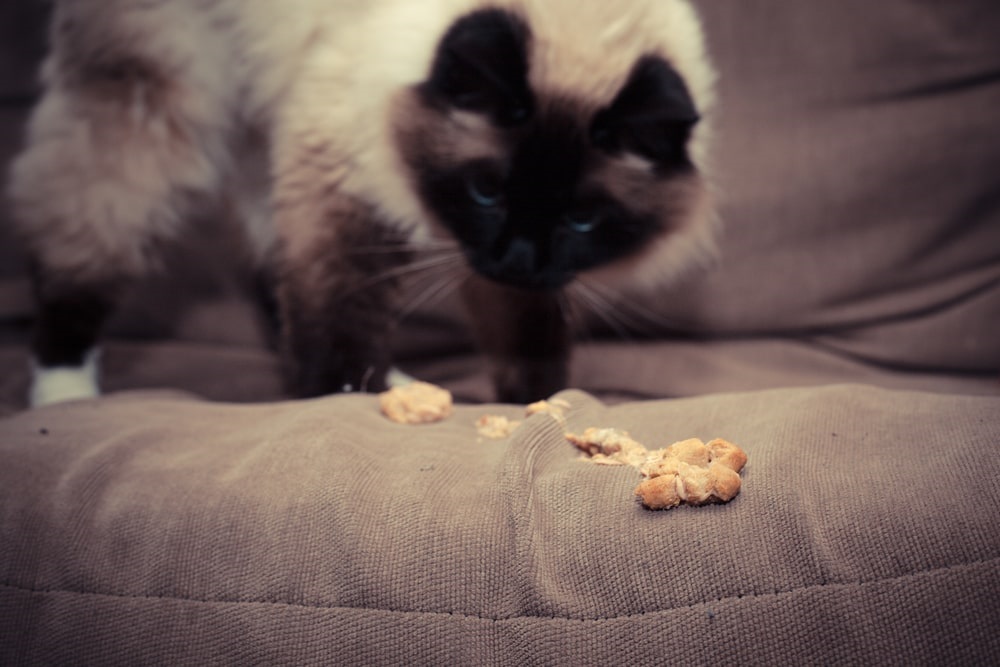
You might have heard about the amazing benefits of consuming wheatgrass and that cats can eat them too.
If you have plants at home, chances are you might have seen your cat occasionally munching on them.
But we have always known our cats to be obligate carnivores or meat eaters.
Is it odd to let your cat nibble on some wheatgrass?
Cats can safely eat wheatgrass in moderation and often benefit from its nutrient-rich composition. It serves as a natural source of fiber aiding digestion, helps in eliminating hairballs, and provides essential vitamins and minerals to complement their diet.
In this article, we will explore more about wheatgrass, discussing potential benefits and precautions for feeding wheatgrass to your cat.
What Is Wheatgrass?
Wheatgrass is actually the grass of the wheat plant.
It grows rather commonly in Europe and US and can be planted both indoors and outdoors.
It is a very easy plant to look after with just the occasional watering and access to sunlight.
To get wheatgrass, you just have to plant the wheat seeds.
Benefits Of Wheatgrass For Humans
Wheatgrass has been reported to contain a good amount of minerals, vitamins and antioxidants such as:
- Vitamin A
- Vitamin B
- Vitamin C
- Calcium
- Magnesium
- Iron
There used to be a wheatgrass health craze a couple of years back. Many health shops were selling wheatgrass juice.
Tried it before and I can’t say I’m a fan of the taste.
Is It Safe For Cats To Eat Wheatgrass?

Yes, it is totally safe for cats to consume wheatgrass.
Wheatgrass has been classified as a safe plant for cats by the ASPCA and you shouldn’t worry if you see your cat grazing on wheatgrass or if you plan to give your cat wheatgrass as a supplement.
If you are growing your own wheatgrass, make sure to not use any pesticide on it as it can be poisonous to your cat when ingested.
On a separate note, if you grow indoor and outdoor plants at home, it is important to know what plants are toxic to cats.
You don’t want to be in a situation where your dear kitty falls seriously ill from chewing on poisonous plants at home.
Do Cats Like To Eat Wheatgrass?
There is no ‘one size fits all’ when it comes to cats eating wheatgrass.
It largely depends on your cat and how keen it is on adding a side of salad to its daily diet.
Cats are generally curious and investigative creatures.
They might find wheatgrass interesting based on the smell and taste.
For cats that like eating wheatgrass, they might actually find it mentally and physically stimulating.
It is interesting to see a cat owner’s expression when you ask them if their cat likes eating wheatgrass.
It’s the same look I give when someone was to ask me “What do cats like to eat for breakfast?”
Is Wheatgrass Good For Cats?

There are a few known wheatgrass benefits for cats that can help improve their health and wellness.
In fact, cats in the wild are known to eat certain plants to help with sickness and ailments.
Weight Loss
“It can be a useful tool to have if you have an overweight cat and needs to lose weight.”
Wheatgrass can be used as an appetite suppressant in cats.
One common advice when trying to lose weight is to eat more fruits and vegetables.
This is due to the high fiber content which helps to keep you full for longer periods.
We can’t expect our cats to turn vegan when trying to lose weight but consuming some wheatgrass can help increase your cat’s fiber intake.
It can be a useful tool to have if you have an overweight cat and needs to lose weight.
A study conducted in 2015 states that wheatgrass is able to increase the metabolic rate and help with weight loss.
Better Blood Flow
Wheatgrass is rich in chlorophyll and folic acid. These two nutrients help in the production of hemoglobin.
The more hemoglobin you have in your blood, the higher the oxygen level in your bloodstream.
This is important for high energy level cats like the Bengal that enjoy playing for a long period of time.
The better flow of well-oxygenated blood can provide more energy for them.
A Source Of Antioxidants
Antioxidants play a crucial role in your cat’s health and well being.
These compounds help to neutralize harmful free radicals in the body, which can contribute to a variety of chronic diseases such as cancer, heart disease, arthritis, etc.
Antioxidants can also help to support your cat’s immune system which is very important for cats with FeLV or FIV.
A study conducted on rabbits showed that wheatgrass was able to “effectively improve cholesterol levels and enhance beneficial antioxidants.”
Hairballs And Harmful Objects

Cats and hairball pretty much go hand in hand.
As cat owners, finding or stepping on a freshly regurgitated hairball is part and parcel of cat ownership.
Even though it is normal for cats to have hairballs, it can be dangerous if the hairball gets too big and gets stuck in the cat’s digestive tract.
Therefore it is important for the cat to vomit or pass out any hairballs in its stomach.
Cats don’t have the enzyme in their stomach to digest plant matter which makes them poop or regurgitate the wheatgrass after eating it.
This process can aid in the removal of hairballs, inedible objects and toxins in the cat’s tummy.
You can check out this article for more natural hairball removal remedies.
Pain Relief For Joints And Muscles
As cats get older, they tend to get joint and muscle aches more frequently just like humans.
Giving your cat wheatgrass can help reduce such inflammation in your cat’s body and provide some pain relief.
A study conducted in 2012 found that chlorophyll which is the green pigment present in green plants such as wheatgrass can help to reduce inflammation.
This strongly suggests that chlorophyll could be potentially useful in developing treatments for inflammation and related diseases.
Wheatgrass For Cats With Kidney Disease
There are some claims that wheatgrass can be beneficial for cats that have chronic kidney disease (CKD).
Wheatgrass contains high levels of Thiamine (vitamin b1) which cats that have CKD can have a deficiency of.
Vitamin B1 is important for cats as it helps regulate the cat’s metabolism and energy levels.
Wheatgrass also contains high levels of chlorophyll which can help increase the blood flow in CKD cats that have anemia.
Wheatgrass For Cats Side Effects
“Wheatgrass can also reduce your cat’s appetite hence you don’t want your cat eating grass as its main diet and neglecting its usual food.”
Wheatgrass is generally safe for cats unless your cat has an unhealthy obsession with it.
One thing cat owners noticed is an increase in the frequency of vomiting and pooping.
This is a natural biological reaction from your cat as it can’t digest the wheatgrass and has to expel it from the body.
If you notice that wheatgrass is making your cat do these things often that it would be best to reduce or control the amount that it consumes.
Wheatgrass can also reduce your cat’s appetite hence you don’t want your cat eating grass as its main diet and neglecting its usual food.
When in doubt, please consult your vet.
Can Cats Eat Wheatgrass Every Day?
Yes, it is fine if your cat wants to get its daily dose of cat grass or wheatgrass. However, one thing to note is the amount of wheatgrass that your cat is eating.
A tiny amount daily is fine but if your cat is spending hours a day just chewing and eating grass then something is not right.
Your cat might be having an addiction to wheatgrass and needs supervision.
The same rules apply if your cat likes eating herbs like sage. A few leaves every now and then are fine but too many can start to upset your cat’s digestive system.
Is Wheatgrass The Same As Cat Grass?
There has always been some confusion between wheatgrass and cat grass but there is no difference between these two
Wheatgrass is basically a certain type of grass that is grown from wheat seeds.
Cat grass is used to describe a number of plants or grasses that cats can safely eat.
For example, oats grass, flax grass and barley grass.
Some of you might let your cat eat moss thinking that it is grass.
I wouldn’t suggest that you allow this as some species of moss can be toxic to cats.
Can Cats Eat Barley Grass?

Yes, cats can eat barley grass or barley sprouts and it is totally safe for them.
Barley grass is part of the cat grass family and provides a good spectrum of vitamins and minerals for your cat.
The grass is tender and sweet and is palatable for your cat.
Cats get the same kind of benefits as they do from eating wheat grass.
Where To Buy Wheatgrass For Cats?
There are many pet stores that sell wheatgrass home kits. Everything is provided in the cat and all you have to do is to add water and sunlight.
There are also some online stores that specialize in selling cat grass.
If you are looking for other species of cat grass, you can try a plant nursery.
Conclusion
Wheatgrass for cats has been shown to have many health benefits and it is fine for your cat to consume wheatgrass on a daily basis.
As nutritious as it can be for cats, don’t forget that your cat is first and foremost an obligate carnivore and should be getting its nutrients from meat.
Use wheatgrass as a supplement for your cat but not as a substitute for its meals.
Iggy Thorne, also known as ‘Iggy the Explorer,’ is a seasoned writer with a flair for adventure and a deep love for animals.
Not only does he craft captivating stories often set in the great outdoors, but he’s also a dedicated pet owner who has owned and fostered both dogs and cats.
His expertise in animal care extends to volunteering at local shelters, making him a credible voice in pet ownership.
With a unique blend of humor and adventure, Iggy’s writing is as engaging as it is informative.

